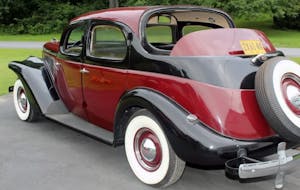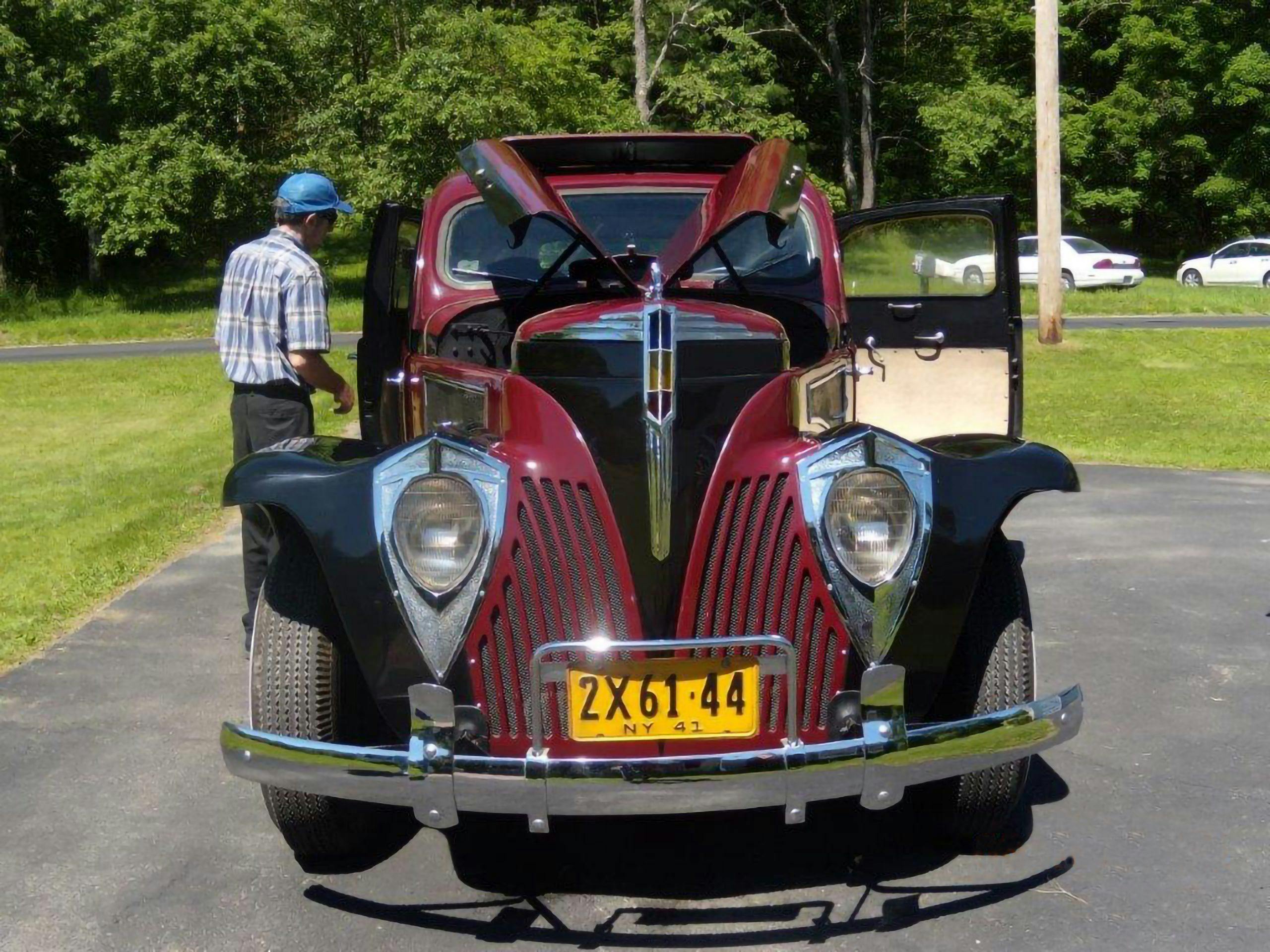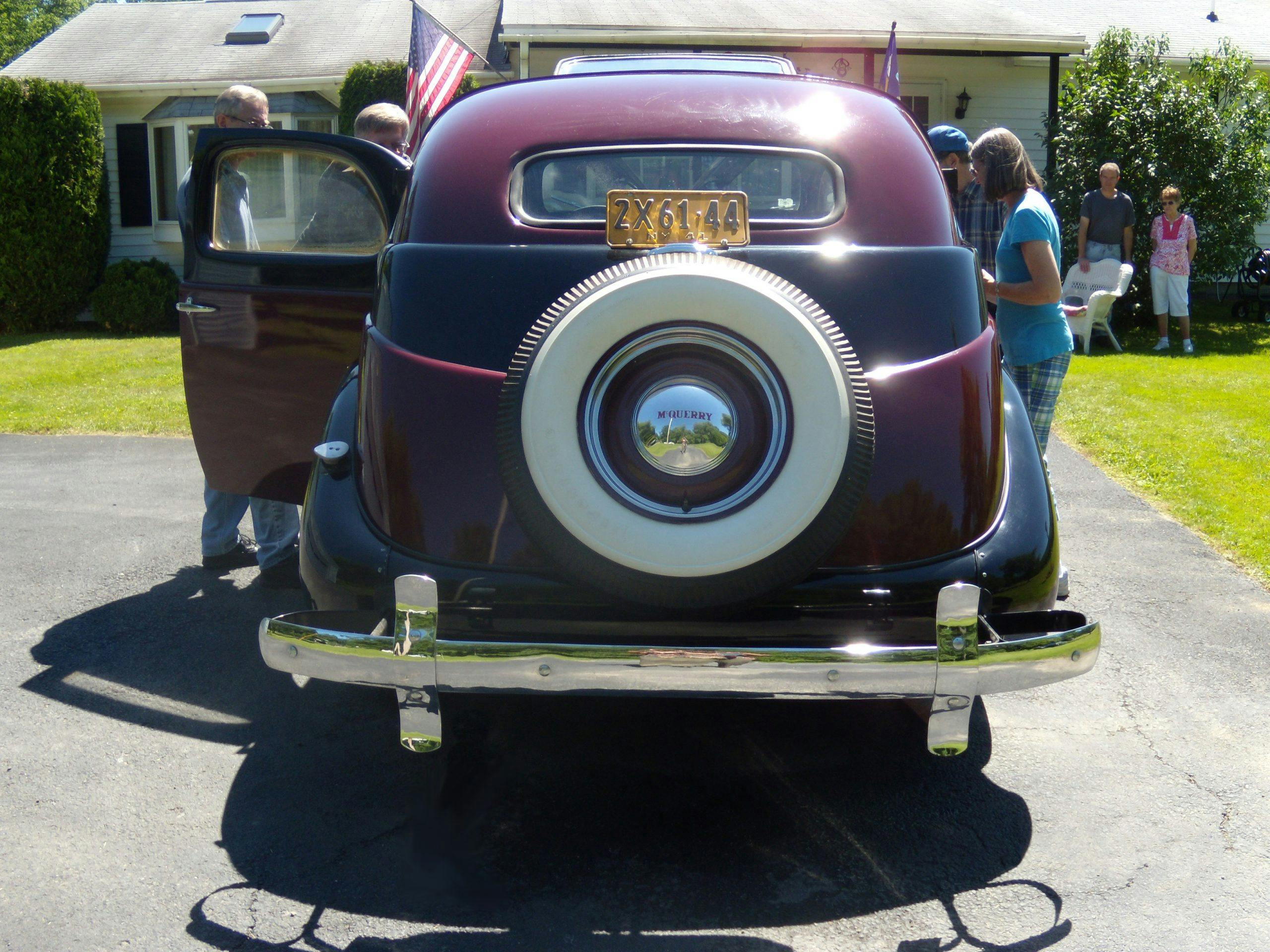Media | Articles
This last-surviving 1939 Art Deco Checker marks the high point of taxi design
The late 1930s was an extraordinary time in automobile design, thanks to the Art Deco movement. In France, Figoni and Falaschi created elegant “teardrop” coupes and roadsters, while Italy’s Alfa Romeo and Czechoslovakia’s Tatra explored aerodynamic forms.
Meanwhile, America flirted with concept cars like the Chrysler Thunderbolt, Buick “Y-Job,” and Rust Heinz’s menacing Cord Phantom Corsair. Some extreme designs made it into production, like the 1938–39 Graham “Sharknose” sedans, although their striking frontal aspect fizzled out at the rear.
But the most outrageous production sedan comes from an unlikely source: Checker, the car maker from Kalamazoo, Michigan, known for indestructible taxicabs. Founded by Russian emigrant Morris Markin in 1922, the company built the famous yellow 1950s Marathon cabs at the rate of 5000–8000 annually, with few design changes, from 1959–82. Checkers scream New York City to every moviegoer, and you could hail one on Broadway as late as 1999.
Checker’s high point—arguably the high point of all taxicab design—occurred 80 years ago. There’s a reason you’ve only ever seen a Model 39A Checker in a period photograph: Of the estimated 1250 built in 1939–41, only one survives today, in upstate New York.

Through a complicated series of acquisitions over 15 years, Checker eventually owned cab companies in New York, Chicago, Pittsburgh, and Minneapolis. That meant that Checker also operated the cars it built and essentially controlled the market.
Marketplace
Buy and sell classics with confidence
Checker cabs evolved from Dodge-like boxes in the ’20s to heavy-duty limousines like the Y-Type of 1934, when the company became part of E.L. Cord’s Auburn/Cord/Duesenberg conglomerate. The Model Y was powered by Auburn’s straight eight-cylinder Lycoming engine, and Cord also built taximeters, controlling yet another aspect of the business. Eventually, the Securities and Exchange Commission focused on Cord’s business practices; when his empire collapsed in 1937, Markin regained control of Checker.
Thanks to Cord’s influence perhaps, Checker paired design flair with practicality in the 1930s—magnificent chrome grilles were flanked by “fly-away” front fenders, so as not to cut tires in fender benders. A 1931 study of 23,000 traffic accidents in New York City reported that 21,000 involved taxis, which certainly supports the decision.
But nobody was ready for the 1939 Model A, which combined practical taxi elements with a vivid artistic sense seldom seen in a workhorse. Raymond Dietrich, a founder of LeBaron coachbuilders, was hired as a consultant in 1938 (at the eye-popping sum of $100 per day) and it’s easy to see his imagination in the new cab.
The Checker Model A featured a full-width fresh air vent above the driver’s head, and an opening glass panel above the rear jump seats, so passengers could see New York City’s skyscrapers. Perhaps the most astonishing touch was the powered retractable rear roof section, which opened over the rear seat like a landaulet carriage (an awning was optional).

The Model A also had a column gearshift to create more space for luggage beside the driver. The driver’s seat could be adjusted 15 ways and the car had a heater so drivers could work longer shifts in comfort. The retractable top precluded a rear opening trunk, since New York City taxi rules specifically forbade that option to prevent taxis being used to smuggle prohibition liquor “and preclude the movement of bodies.”
Huge diamond-shaped headlamp surrounds bracketed the alligator hood with a cloisonné inserts. The 39A was the mechanical equivalent of the Budweiser Clydesdales: It was dressed to kill, but was itself unkillable. After a production life of barely two years (before the U.S. entry into WW II), the 1250 models built soldiered on until as late as 1954, recording more than one million miles apiece.
Meanwhile, Checker took on war work, making the G518 Ben Hur trailers, which were towed into combat behind innumerable Jeeps, and Markin reportedly destroyed the Model A dies. When the war ended, Checker had no new model to replace the veteran A series and wasted a couple of years developing first the Model B, which featured a rear-mounted transverse RWD six-cylinder Continental engine, then the Model C with a transverse FWD six-cylinder powerplant.
The final FWD Model D was tested for 100,000 miles, at which point it was deemed too expensive to build. So a conventional Model A2 was introduced in 1946, looking like the competition DeSoto with a Dodge grille.
Sadly, it lacked all of the imaginative elements which made its predecessor unique. It was followed by the A3, which was sold to the public; and A4 and A5 largely with the same body, but with an opening trunk. In the mid-1950s the boxy A8 foreshadowed the iconic A9, A11 and A12 with which the brand is usually identified.
Period photos of the Model A at work are fairly easy to find, and have one thing in common—they look like they were beaten to death. The sole surviving 39A escaped through a quirk of fate. The present owner believes it was bought by a resort in upstate New York near Monticello to ferry guests to and from the railroad station, winding up in a junkyard in the 1950s. There it lay until the mid-1960s, when the owner of another wrecking yard discovered it and traded it for an old Chevrolet. Arthur J. (Jim) Baudendistal was a Ford man, but he was intrigued by the unusual car and took it home. When two passing Checker fans recognized it excitedly, he began a long restoration.
The job would involve all of his seven children, says his daughter Mary Spencer. One son took an auto body class, another was a skilled mechanic who rebuilt a 262-cubic-inch Continental six-cylinder engine (the family still has the original one). Yet another son replaced the wood inside the doors and repaired the retractable roof, while the two sisters refinished the instruments. The chrome plating was redone—“Hubcaps were the hardest thing to find,” Mary says—and a glass artist replaced the hood ornament inserts.
“It was a complete family project,” Mary says. “One Christmas we all bought Dad a set of whitewall tires.” The Checker was originally black, but an old craftsman sent Baudendistal a scale model painted in magenta and black. “Dad was so taken with the colors, he repainted the car to look just like it.”
Taxi historian Mike Angelich wrote a comprehensive history of Checker and says a number of factors contributed to the disappearance of the Model A. “Checker didn’t have a new car until 1947, and there were problems with the Model A. The glass panel leaked; so did the opening at the front and the disappearing roof. That little awning at the back (to keep the sun off rear passengers) was just a gimmick. But they must all have done close to a million miles.”

Jim Garrison, of Kalamazoo, worked for Checker for 32 years as a tool-and-die maker and is a past president of the Checker club. He estimates 250,000 Checkers were built altogether and about 1000 are still running. When the last taxi left the factory in 1982, Checker’s final 25 years involved heavy-duty stamping and die contracts for GM, work for which the company was particularly well qualified.
“Of all pre-1958 Checkers, there are about two dozen—mostly in poor condition,” Garrison says. “Old Checkers are among the rarest of cars because, as taxis, they were all scrapped when done with service, and there was little personal or public interest in fleet cars. Almost all of the remaining Checkers are from 1962 and later.”
Joe Fay is a lifelong Checker aficionado who has tracked survivors through the decades. There are surprisingly few. The 1920s are represented by two Model H examples—one in the Gilmore Museum and one in Hollywood—plus a Model G pickup. The 1930s count one 1933 Model T, an ex-Harrah collection Model M taxi, and a model M farm truck. Two 1936 Model Y survivors include a sedan in Texas and a tow truck conversion.
There is only one 1939 Model A, but surprisingly, about a dozen 1946–50 A2s survive in Finland. Faced with a shortage of cabs for the 1954 Winter Games in Helsinki, the Finns imported 500 very tired A2 Chicago taxis, 100 of which were still running in 1960. There’s also a solitary 1949 A3 civilian sedan in Illinois.
One 1950 A4 went from New York City to MGM in Hollywood, and Fay owns it. Plus there’s a lone A6 survivor in Finland. Rounding out the pre-A11 Marathon line of 1958–82 are four known 1956–58 A8 survivors and one wreck.
A 2014 gathering of Checker cabs in New York attracted 50 cars and merited stories in several newspapers and magazines, but Jim Garrison has even bigger plans for August 2022, which will mark Checker’s 100th anniversary. Garrison is planning a rendezvous at the Gilmore Museum and intends to round up all the Checkers that can get there—including the Model 39A.
So now you know the answer to the perennial taxicab question, “Where to?”








